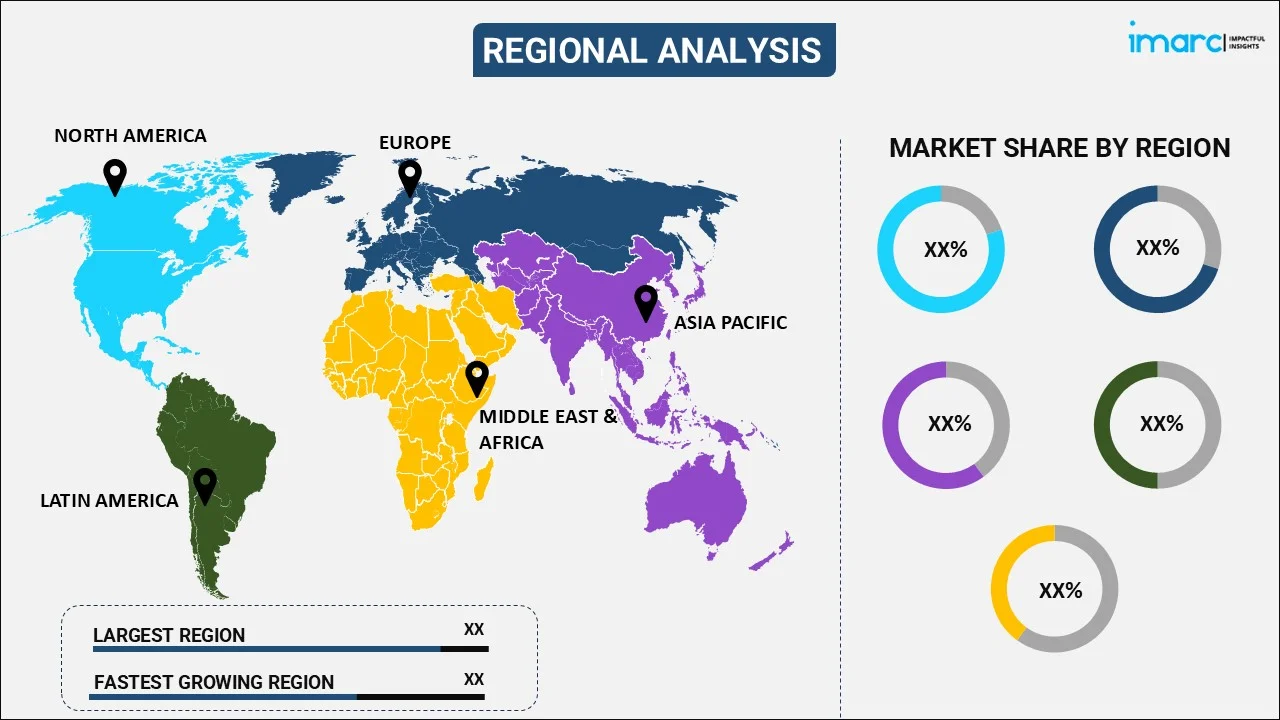
Soundbar Market Report by Type (Wall-Mounted, Table-top, and Others), Installation Method (Active Soundbars, Passive Soundbars, and Others), Connectivity (Wi-Fi, Bluetooth, and Others), Application (Home Audio, Commercial, and Others), and Region 2025-2033
Market Overview:
The global soundbar market size reached USD 4.2 Billion in 2024. Looking forward, IMARC Group expects the market to reach USD 8.0 Billion by 2033, exhibiting a growth rate (CAGR) of 7.4% during 2025-2033. The increasing product utilization in households, growing demand for wireless streaming of audio contents, growing expenditure capacities of consumers and extensive research and development (R&D) activities are some of the major factors propelling the market.
|
Report Attribute
|
Key Statistics
|
|---|---|
|
Base Year
|
2024
|
|
Forecast Years
|
2025-2033
|
|
Historical Years
|
2019-2024
|
|
Market Size in 2024
|
USD 4.2 Billion |
|
Market Forecast in 2033
|
USD 8.0 Billion |
| Market Growth Rate 2025-2033 | 7.4% |
Soundbar is a compact and elongated audio system that enhances the sound experience of televisions (TVs) and home theatre systems. It is comprised of multiple speakers, an amplifier, a control interface, an audio processing system, power supply, and enclosure. Soundbar is widely used in households, video gaming applications, movie theatres, educational institutions, museums, art galleries, cafes, hotels, and restaurants. It is a cost-effective, user-friendly, and aesthetically pleasing product that can be connected to multiple devices and provides an immersive experience for music, movies, and gaming. Soundbar also offers a wide range of connectivity options that allow users to enjoy audio/visual contents on smartphones, tablets, and other compatible devices.

The growing demand for enhanced audio experience is one of the primary factors favoring the market growth. Soundbar is equipped with highly effective and superior-quality speakers and amplifiers that provide an immersive sound experience without the complexity of traditional home theatre systems. Along with this, the increasing consumer awareness towards the various advantages of soundbars over built-in speaker systems in television (TVs) and other entertainment systems is acting as another growth-inducing factor. Furthermore, the rising product adoption due to its sleek design and aesthetic appeal, which saves space, eliminates the need for multiple speaker systems, and enables easy installation on walls and other places, is providing an impetus to the market growth. Moreover, the widespread product utilization due to the rising number of streaming services and over-the-top (OTT) platforms is contributing to the market growth. Other factors, including growing expenditure capacities of consumers, aggressive promotional activities by manufacturers, and increasing product availability across various online retail platforms, are anticipated to drive the market growth.
Soundbar Market Trends/Drivers:
The increasing product utilization in households
Soundbars find numerous applications in households due to their versatility and ability to enhance the audio experience. They are widely used to enhance the audio quality of televisions (TVs) as the built-in speakers lack the power and clarity to deliver immersive sound. Apart from this, they are also used for music playbacks as they can be easily connected with smartphones and tablets, thus allowing users to access a vast library of songs directly through soundbars. Furthermore, the widespread product utilization in home gaming setups to enhance sound effects, positional audio, and immersive surround sound, which allow gamers to accurately locate in-game sounds and enjoy a more engaging gameplay experience, is providing a thrust to the market growth. Additionally, the growing product adoption as part of the home theatre systems to provide cinematic audio experience and complement visuals is supporting the market growth.
The growing demand for wireless streaming of audio content
Soundbar is widely adopted by individuals as it features wireless connectivity, such as Bluetooth and Wi-Fi, which enable users to enjoy movies and music conveniently and provides freedom to move around freely without the hassle of connecting cables or docking devices. Along with this, it offers uncompromising audio quality with wireless connections that enhances user comfort and provides an immersive sound experience. Moreover, the wireless nature of soundbars offers flexible placement options that allow users to place them on walls, shelves, or in front of televisions (TVs). Apart from this, the rapid proliferation of smartphones, tablets, and laptops that can be seamlessly connected to soundbars with wireless connectivity and allow users to enjoy audio content on a diverse range of devices is positively influencing the market growth.
Extensive research and development (R&D) activities
The recent development of smart soundbars that enhances the audio experience and offers additional functionalities, such as voice control, smart home integration, multi-room audio capability, and remote access through mobile applications, is positively influencing the market growth. Additionally, the introduction of adaptive sound technology that analyzes the audio signals and optimizes the sound settings in real-time to provide the best audio experience for movies, music, or dialogue is contributing to the market growth. Moreover, the utilization of artificial intelligence (AI) to simulate surround sound experience, improve dialogue clarity, and suppress unwanted background noises is providing a thrust to the market growth.
Soundbar Industry Segmentation:
IMARC Group provides an analysis of the key trends in each segment of the global soundbar market report, along with forecasts at the global, regional, and country levels from 2025-2033. Our report has categorized the market based on type, installation method, connectivity, and application.
Breakup by Type:

- Wall-Mounted
- Table-top
- Others
Table-top dominates the soundbar market
The report has provided a detailed breakup and analysis of the soundbar market based on the type. This includes wall-mounted, table-top, and others. According to the report, table-top represented the largest market segment.
The table-top soundbar is a compact and space-efficient audio solution, which is designed to be placed on a table, television (TV) stand, or mounted on a wall. It is a cost-effective, user-friendly, and easy-to-install product that takes up minimal space compared to traditional multi-speaker setups. The table-top soundbar also offers improved audio performance and better sound dispersion and separation, which leads to increased clarity, enhanced dialogue intelligibility, and impactful bass response. Furthermore, it provides a sleek, minimalistic, and stylish design that complements modern TV aesthetics. Apart from this, table-top soundbars offer versatile connectivity options to accommodate various audio sources, such as TVs, gaming consoles, smartphones, or streaming devices.
Breakup by Installation Method:
- Active Soundbars
- Passive Soundbars
- Others
Passive soundbars dominate the soundbar market
The report has provided a detailed breakup and analysis of the soundbar market based on the installation method. This includes active soundbars, passive soundbars, and others. According to the report, passive soundbars represented the largest market segment.
Passive soundbars are dominating the market as they are designed with multiple drivers that offer exceptional sound quality and performance. They deliver a more immersive and cinematic audio experience by allowing better control over the audio output, which results in clearer highs, detailed mid-range, and impactful bass. Apart from this, passive soundbars also provide a high level of customizability and expandability, as they are modular in nature and can be fine-tuned and upgraded to meet desired audio requirements. Furthermore, they can be easily integrated with the existing audio system, thus making them an ideal choice for consumers. Moreover, passive soundbars are also highly durable products that offer long service life and require low maintenance.
Breakup by Connectivity:
- Wi-Fi
- Bluetooth
- Others
Bluetooth dominates the soundbar market
The report has provided a detailed breakup and analysis of the soundbar market based on connectivity. This includes Wi-Fi, Bluetooth, and others. According to the report, Bluetooth represented the largest market segment.
Bluetooth connectivity holds the majority share owing to its wireless and hassle-free audio streaming experience. Furthermore, it allows users to easily connect soundbars with their smartphones, tablets, or other Bluetooth-enabled devices without the need for cables or complicated setup procedures. Along with this, Bluetooth offers universal compatibility, which ensures that consumers can easily connect their devices to Bluetooth-enabled soundbars, regardless of the brand or operating system. Moreover, it is user-friendly and easy to set up, as it automatically recognizes the connected device for future use. Apart from this, Bluetooth connectivity is cost-effective and offers excellent signal transfer capabilities over an extended range.
Breakup by Application:
- Home Audio
- Commercial
- Others
Home audio dominates the soundbar market
The report has provided a detailed breakup and analysis of the soundbar market based on the application. This includes home audio, commercial, and others. According to the report, home audio represented the largest market segment.
Soundbars are widely used in home audio applications, as they are compact and space-efficient audio solutions that provide clean and minimalistic aesthetics. Along with this, they offer an enhanced audio experience without the need for multiple speaker setups and complicated wiring, thus making them an attractive option for homeowners who value simplicity and space optimization. Moreover, soundbars are easy to install and come with user-friendly interfaces and straightforward connectivity options. Additionally, they provide a considerable improvement in dialogue clarity, bass response, and overall audio balance, which enhances the enjoyment of movies, TV shows, and video gaming. Apart from this, soundbars are highly accessible and can be purchased through online platforms or physical retail stores.
Breakup by Region:

- North America
- United States
- Canada
- Asia Pacific
- China
- Japan
- India
- South Korea
- Australia
- Indonesia
- Others
- Europe
- Germany
- France
- United Kingdom
- Italy
- Spain
- Russia
- Others
- Latin America
- Brazil
- Mexico
- Others
- Middle East and Africa
- Turkey
- Saudi Arabia
- Others
North America exhibits a clear dominance in the market, accounting for the largest soundbar market share
The report has also provided a comprehensive analysis of all the major regional markets, which includes North America (the United States and Canada); Asia Pacific (China, Japan, India, South Korea, Australia, Indonesia, and others); Europe (Germany, France, the United Kingdom, Italy, Spain, Russia, and others); Latin America (Brazil, Mexico, and others); and the Middle East and Africa (Turkey, Saudi Arabia, and others). According to the report, North America represented the largest market segment.
North America represents the largest market for soundbars due to the rising disposable incomes. Furthermore, the presence of a strong home theatre culture in the region is facilitating product demand, as it aids in enhancing the audio component of home theaters, thus delivering better sound quality and surround sound effects. Moreover, the increasing product adoption owing to the growing consumer preference for minimalistic home aesthetics is supporting the market growth. Apart from this, the easy accessibility of soundbars to consumers due to the presence of a well-established retail infrastructure and distribution channel in the region is favoring the market growth.
Competitive Landscape:
Key players in the soundbar market are actively engaged in innovative projects to incorporate new features and technologies, such as audio quality, compatibility with various devices, and advanced connectivity features, including Wi-Fi, Bluetooth, and voice assistance. In line with this, the growing focus on aesthetics is promoting designers to manufacture products with sleek and stylish looks that seamlessly blend with the modern home interior, which is acting as another growth-inducing factor. Moreover, aggressive promotional activities by manufacturers through social media campaigns, influencer marketing, and television (TV) commercials to improve brand visibility and expand existing customer base are providing an impetus to the market growth. Apart from this, the increasing strategic partnerships and collaboration between top companies and television brands, streaming platforms, or content providers to expand global presence, increase sales, and improve profitability is supporting the market growth.
The report has provided a comprehensive analysis of the competitive landscape in the global soundbar market. Detailed profiles of all major companies have also been provided. Some of the key players in the market include:
- Bose Corporation
- Edifier International Limited
- Harman International Industries, Incorporated
- LG Electronics
- Panasonic Corporation
- Polk Audio, LLC
- Samsung Group
- Sennheiser electronic GmbH & Co. KG
- Sony Corporation
- Yamaha Corporation
Recent Developments:
- In October 2022, Bose Corporation announced the launch of the new “Smart Soundbar 600”, a compact, sleek designed product that features Dolby Atmos and its TrueSpace technology to deliver exceptionally immersive audio for its size.
- In January 2020, JBL, a brand owned by Harman International Industries, introduced JBL Bar 9.1, its first soundbar with Dolby Atmos that creates true wireless surround sound with crowd-pleasing JBL Original Pro Sound.
- In December 2022, LG Electronics unveiled its soundbar lineup for 2023, comprising three models that support Dolby Atmos and come with IMAX-enhanced adaptation.
Soundbar Market Report Scope:
| Report Features | Details |
|---|---|
| Base Year of the Analysis | 2024 |
| Historical Period | 2019-2024 |
| Forecast Period | 2025-2033 |
| Units | Billion USD |
| Scope of the Report | Exploration of Historical and Forecast Trends, Industry Catalysts and Challenges, Segment-Wise Historical and Predictive Market Assessment
|
| Types Covered | Wall-Mounted, Table-top, Others |
| Installation Methods Covered | Active Soundbars, Passive Soundbars, Others |
| Connectivity Covered | Wi-Fi, Bluetooth, Others |
| Applications Covered | Home Audio, Commercial, Others |
| Regions Covered | North America, Asia Pacific, Europe, Latin America, Middle East and Africa |
| Countries Covered | United States, Canada, Germany, France, United Kingdom, Italy, Spain, China, Japan, India, South Korea, Australia, Indonesia, Brazil, Mexico, Turkey, Saudi Arabia |
| Companies Covered | Bose Corporation, Edifier International Limited, Harman International Industries, Incorporated, LG Electronics, Panasonic Corporation, Polk Audio, LLC, Samsung Group, Sennheiser electronic GmbH & Co. KG, Sony Corporation and Yamaha Corporation |
| Customization Scope | 10% Free Customization |
| Post-Sale Analyst Support | 10-12 Weeks |
| Delivery Format | PDF and Excel through Email (We can also provide the editable version of the report in PPT/Word format on special request) |
Key Benefits for Stakeholders:
- IMARC’s report offers a comprehensive quantitative analysis of various market segments, historical and current market trends, market forecasts, and dynamics of the soundbar market from 2019-2033.
- The research study provides the latest information on the market drivers, challenges, and opportunities in the global soundbar market.
- The study maps the leading, as well as the fastest-growing, regional markets. It further enables stakeholders to identify the key country-level markets within each region.
- Porter's five forces analysis assist stakeholders in assessing the impact of new entrants, competitive rivalry, supplier power, buyer power, and the threat of substitution. It helps stakeholders to analyze the level of competition within the soundbar industry and its attractiveness.
- Competitive landscape allows stakeholders to understand their competitive environment and provides an insight into the current positions of key players in the market.
Key Questions Answered in This Report
The global soundbar market was valued at USD 4.2 Billion in 2024.
We expect the global soundbar market to exhibit a CAGR of 7.4% during 2025-2033.
The rising demand for soundbars, as they offer an enhanced audio and premium viewing experience to users by eliminating the need for elaborate setups, external wiring, and various speakers, is primarily driving the global soundbar market.
The sudden outbreak of the COVID-19 pandemic had led to the implementation of stringent lockdown regulations across several nations, resulting in the temporary closure of numerous manufacturing units for soundbars.
Based on the type, the global soundbar market has been divided into wall-mounted, table-top, and others. Among these, table-top currently exhibits a clear dominance in the market.
Based on the installation method, the global soundbar market can be categorized into active soundbars, passive soundbars, and others. Currently, passive soundbars account for the majority of the global market share.
Based on the connectivity, the global soundbar market has been segregated into Wi-Fi, Bluetooth, and others. Among these, Bluetooth currently exhibits a clear dominance in the market.
Based on the application, the global soundbar market can be bifurcated into home audio, commercial, and others. Currently, home audio holds the largest market share.
On a regional level, the market has been classified into North America, Asia Pacific, Europe, Latin America, and Middle East and Africa, where North America currently dominates the global market.
Some of the major players in the global soundbar market include Bose Corporation, Edifier International Limited, Harman International Industries, Incorporated, LG Electronics, Panasonic Corporation, Polk Audio, LLC, Samsung Group, Sennheiser electronic GmbH & Co. KG, Sony Corporation, Yamaha Corporation, etc.
Need more help?
- Speak to our experienced analysts for insights on the current market scenarios.
- Include additional segments and countries to customize the report as per your requirement.
- Gain an unparalleled competitive advantage in your domain by understanding how to utilize the report and positively impacting your operations and revenue.
- For further assistance, please connect with our analysts.
 Inquire Before Buying
Inquire Before Buying
 Speak to an Analyst
Speak to an Analyst
 Request Brochure
Request Brochure
 Request Customization
Request Customization




.webp)




.webp)












